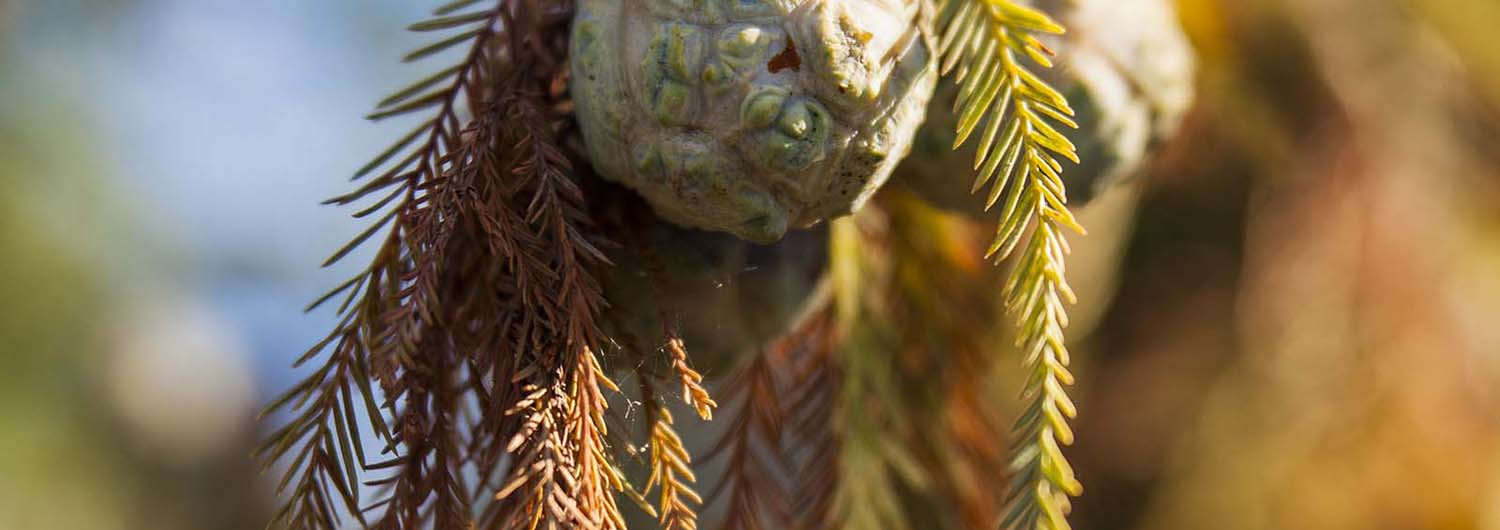Friends of the JC Raulston Arboretum Newsletter
Fall 2018 – Vol. 21, No. 2
Director's Letter
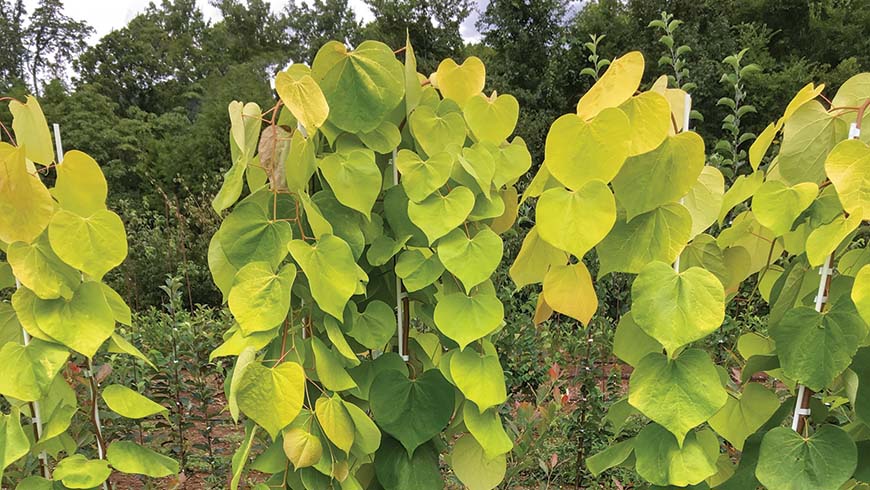
Greetings from the JC Raulston Arboretum
By Mark Weathington, Director
The consistently hot weather this summer was alleviated, at least in part, by consistent rain for us, which was quite welcome, as we have been planting like mad. Altogether, 2018 has been a year of extremes with long stretches of cold winter temperatures followed by a scorcher of a summer. We welcome these extremes as they give us a chance to evaluate our collection's responses. Gardens manager Doug Ruhren's observations on how some of the plants coped with the winter can be found on pages three and four, and my notes will certainly inform the completion of my evergreen oak evaluation whose introduction can be found on pages five and six.
Our members and supporters are what allow us to continue growing and thriving, and we were spoiled for choices regarding members making news. Well-deserved awards for Tony Avent of Plant Delights Nursery and former JCRA director Bob Lyons top the list. They both are woven deeply into the fabric of the Arboretum through their incredible work over the years. The world-class plant breeders from NC State University, including former JCRA director Denny Werner, are also making headlines. Denny's new redbuds are game changers. You'll see a sneak peek on page two, but you may have to wait a year or so before you can find them in your garden center. Tom Ranney's breeding work isn't just beautifying the landscape, but also saving lives. Check out page seven for more information about that.
Our interns are spreading around as well. Two recent intern moves include Taylor Leesnitzer taking on the Iris collection and more at the Missouri Botanical Garden and Amanda Wilkins starting her new job as the curator for the Juniper Level Botanic Garden at Plant Delights Nursery. Please join me in wishing them much success.
With nearly 100 people moving to Wake County alone each day, it has long been a goal of mine to offer a free program to teach people how to garden with our unique challenges here in the South. To that end, I wrote a book on the topic, but we wanted to do more. This summer, we kicked off our free Gardening in the South series aimed at new gardeners and recent transplants to the area. Find out more about this great program on page nine and invite your new neighbors and coworkers to join in on the next one.
Thanks to our supporters, we have a newly refurbished York Auditorium to hold our educational classes. New carpets, new wall coverings, new folding wall panels—we are loving the face-lift! Check it out on page eight. Or better yet, swing by for a visit.
Thank You
Special thanks to our 2017–2018 donors who sponsored and supported year-end projects at the $5,000 level and above:
Keith and Margie Collins
The Doris Deal Foundation
Karen and David Duch
Linda and Rufus Edmisten
Nina and Jerry Jackson
Amelia and Richard Lane
Jim Schlitt
Taylor's Nursery
Horticulture
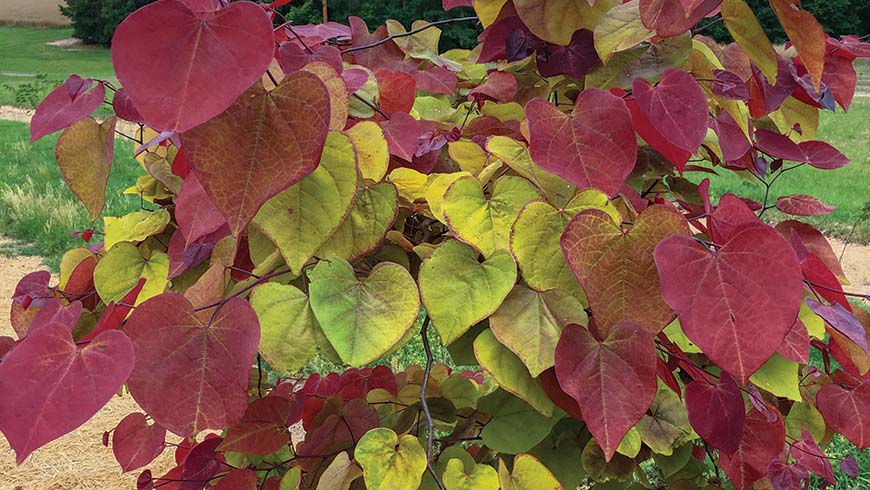
New Plants from the JCRA
By Mark Weathington, Director
New plants are the lifeblood of today's nursery industry and the JC Raulston Arboretum has long been at the forefront of bringing new plants into production. By our count, the JCRA has named and introduced over 50 plants so far. Of course, not included in this number are the many hundreds of plants that we have been instrumental in introducing to the nursery industry, promoting out of obscurity, and bringing in from foreign sources. We believe that introducing new plants to the public is one of the primary ways we support our mission, whether it is by finding and collecting overlooked plants in our own backyard and around the world or by actively breeding plants with new and superior characteristics
This two-pronged approach has resulted in plants like the still popular Styrax japonicus 'Emerald Pagoda' (Japanese snowbell) found in the Republic of Korea and the breakthrough hybrid Calycanthus ×raulstonii 'Hartlage Wine' (Raulston allspice). Around 2008 and shortly thereafter, the JCRA released several new plants including dwarf, nearly sterile butterfly bushes like Buddleja 'Blue Chip' and 'Miss Ruby' as well as several popular redbuds, including the world-wide favorite Cercis canadensis 'Ruby Falls' from the breeding program of then director, Denny Werner, Ph.D.
Denny has recently returned to the Arboretum as plant breeder and emeritus director to continue his breeding in his retirement from the faculty of NC State University. This fall marks the JCRA–Denny Werner first new introductions as a result of this partnership. To add to Denny's already amazing Cercis (redbud) introductions comes the first ever weeping gold-leaf redbud, aptly named 'Golden Falls' (header, Director's Letter). This breakthrough plant grows much like Denny's other weeping redbuds, but with screaming gold leaves after the lavender-pink spring flowers, and is sure to be a big hit. Denny's other new redbud, 'Flamethrower' (above), almost defies description with a mixture of burgundy, gold, and coppery leaves adding some exotic heat to the garden.
As the JCRA continues in its endeavors to support the Green Industry and home gardeners, we anticipate plant breeding and introduction of truly different and superior plants to become even more important. We look forward to many more exciting plants from our partnership with Denny. The future looks awfully bright. Or is that just sunshine on 'Golden Falls'?
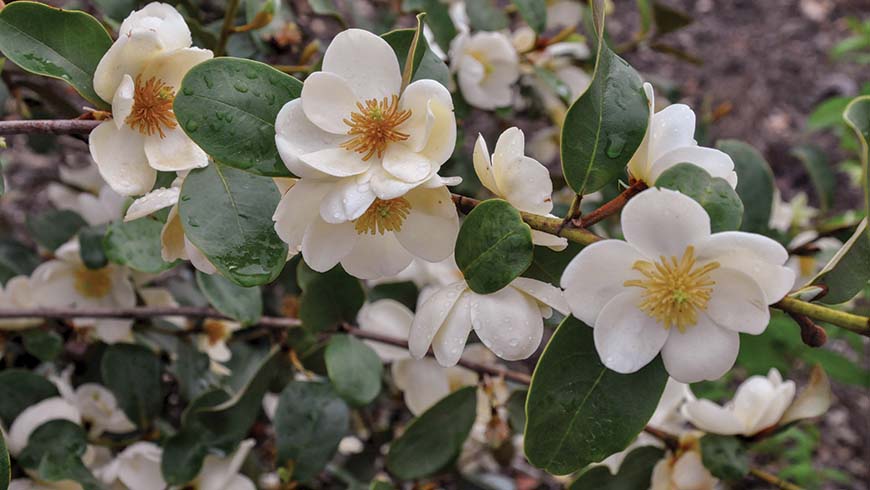
A Reckoning
By Douglas Ruhren, Gardens Manager
The winter of 2017/2018 might seem like a distant memory on a 95°F summer day except that the effect of 200 hours of below-freezing temperatures is still evident in the JCRA. Though as gardeners we might wish that our plants never suffer from winter's cold, a winter such as the one just past is priceless in the evaluation of a plant's suitability to our climate. And evaluating plants is one of the most significant roles of the JC Raulston Arboretum.
The duration of this cold period is probably more significant than the actual low temperature, especially on herbaceous perennials. What is most typical of cold spells here is that the ground freezes overnight but thaws out during the day. Therefore, the ground does not freeze deeply, so many herbaceous plants manage to survive. Two hundred continual hours of below freezing temperatures meant that frost penetrated much more deeply than normal. How deep I don't know. If I could go back in time I would dig into the soil to determine this. Next time.
Few elephant ears, mainly Colocasia and Alocasia, have returned this year, even ones which had survived many winters prior to this one. Tim Alderton and I have been trying to determine why the Geophyte Border display is a bit thin this year. Some of the hardy Sinningia (above) were slow to start this year and aren't yet up to full steam. It still seems amazing that any relative of African violets would be winter-hardy at all. The cold seems to have impacted a few of the false shamrocks (Oxalis) and rain lilies (Zephyranthes and Habranthus) as well.
Rohdea chinensis (Chinese sacred lily) melted away in the cold like overcooked spinach, which is a shame since one of its assets is that it is potentially evergreen. It has returned but looks very weak. Rohdea japonica, on the other hand, suffered no cold damage and is hardy into at least the warm end of zone 6. The three plants of Rohdea chinensis planted in the Arboretum are all the same cultivar, 'Green Panda'. Perhaps this one cultivar does not represent the hardiness of R. chinensis as a whole. Until fairly recently, the genus Rohdea was thought to be monotypic (one species) but now there are about 18 named species which represent 16 more for the JCRA to trial.
Rohdea's relative, Aspidistra, is another genus of herbaceous perennials valued for its evergreen foliage, but many of them were browned by this cold spell.
On the other hand, Begonia formosana survived this winter, which is significant information for this little known species. A quick rundown of herbaceous perennials more commonly thought of as being tender but which have been coming through decades of winters, including this one, are: Tradescantia pallida 'Purpurea' (purple heart), Tradescantia sillamontana (white velvet tradescantia), Acalypha repens (trailing chenille plant), Abutilon megapotamicum 'Little Imp' (flowering maple), and Abelmoschus manihot (golden hibiscus).
Amongst the vast number of woody residents of the JCRA it is the broadleaf evergreen trees and shrubs that are the ones most likely to suffer in cold winters. The evergreen magnolias from Asia exhibited a wide range of responses to the cold, from none to death. Magnolia delavayi died to the ground but is regrowing. M. cavaleriei in the Lath House completely defoliated, but has leafed out though it does look weak. Yet M. cavaleriei var. platypetala behind the Perennial Border sustained no damage and flowered fully. One specimen of each does not allow for any conclusions other than perhaps that individuals of the species vary in their cold hardiness. About 20' from the first M. cavalierei is a handsome specimen of M. lotungensis which had no cold damage. It is much taller than wide and architecturally very striking. Magnolia maudiae survived the winter untouched and flowered nicely.
Different cultivars of Magnolia laevifolia vary in their cold hardiness. 'Michelle' has been getting clobbered for many a winter, which is sad since it is named for the late Michelle Avent. 'Gail's Favourite' (above) on the other hand has not been damaged by any winter since it was planted in 2011. If 'Gail's Favourite' hasn't already entered the nursery trade it truly deserves to. It covers itself with cream-white, bowl-shaped blooms in the spring. Clearly, a winter such as this was valuable in showing which individuals are truly zone 7 hardy.
Schefflera delavayi looks impossibly tropical to survive even a mild winter, but it came through this one without damage. Fatsia polycarpa did lose a little bit of growth, but I still consider it worth growing because its snowflake-like leaves are so beautiful. Plus, it's in one of the raised beds in the Lath House and I suspect that 200 hours of below-freezing temps meant that the whole raised bed froze solid, something that wouldn't have happened in a typical garden bed.
Rhodoleia is an evergreen relative of Hamamelis (witchhazels). The two plants of Rhodoleia henryi in the raised beds of the Lath House lost most of their foliage and some wood, but are surviving. The one plant of Rhodoleia championii in the ground by the Bobby G. Wilder Visitor Center was not damaged at all. Rhodoleia parvipetala died outright this winter even in a protected spot. Though these represent three species within one genus, it would be bad science to conclude anything as to relative hardiness of the three species or the impact of their growing conditions. However, there is ample room for hope that we will succeed in growing and flowering this genus.
This is far from a comprehensive accounting of this winter's effect on the plants in the JCRA and does not represent a systematic review of them. Perhaps this will come to be if time permits. It does suggest the value in planting out multiple seedlings and or cultivars of any one species because it is clear that variations in cold hardiness do occur within a species. Therefore, the silver lining to the dark cloud of 200 continuous hours of below-freezing temperatures is that the JCRA has a better idea of what plants are truly suitable to winter-hardiness zone 7.
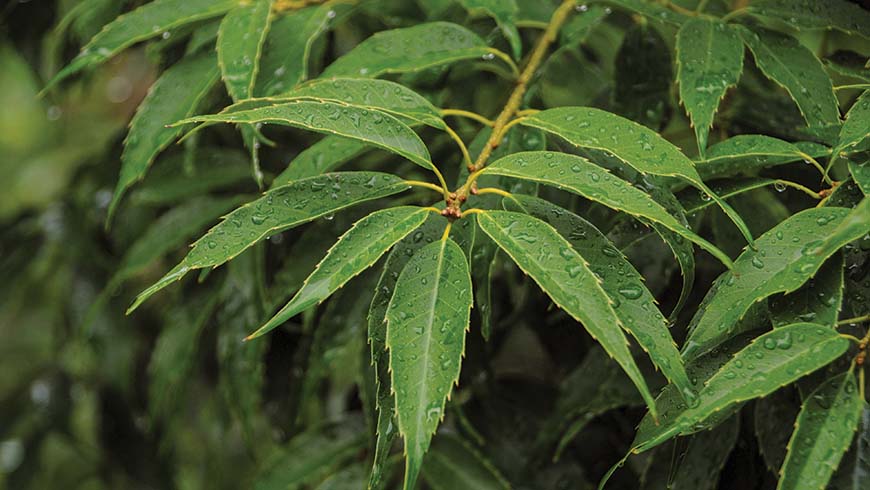
Evergreen Oaks at the JC Raulston Arboretum
By Mark Weathington, Director
As a research and evaluation collection, the JCRA often participates in a variety of professional and specialty conferences. In recent years, we've presented talks to the American Public Gardens Association, International Plant Propagators' Society, Southern Nursery Association, and Botanic Gardens Congress International, to name just a few. Among our favorite places to take a deep dive into the collections is with the hardcore plant nuts in the various plant societies like the Magnolia Society International and the Maple Society. This fall, I'll be making a 27-hour layover in California on my way back from China to talk to the International Oak Society about evergreen oaks at the JC Raulston Arboretum. Here is a sneak peek at selected portions of the paper accompanying the talk, minus footnotes and references.
The JC Raulston Arboretum evaluates a wide diversity of woody plants for suitability to the central Piedmont region of North Carolina and the broader southeastern United States. Quercus (oaks) have been an important component of the collections of the JCRA since its inception in 1976. The first plant installed by J. C. Raulston when establishing the Arboretum was Quercus robur f. fastigiata, a farewell gift from a colleague at Texas A&M University. In recent years, evergreen and semi-evergreen species have gradually been accumulated through wild collections and from cultivated material to add to the existing specimens that pre-dated the Arboretum. Many of these Quercus are poorly understood and rarely grown in Western gardens, but may be suitable for wider use throughout the southern United States.
The genus Quercus is comprised of 400−600 species in the Fagaceae (beech family) with new species and naturally occurring hybrids being described with some regularity. The genus ranges across North America south through Central America to Columbia, Europe, north Africa, and Asia where it crosses into the southern hemisphere. The center of diversity is in southern Mexico where the genus is undergoing active speciation. Where species overlap throughout their native ranges or in cultivation, there can be considerable hybridization. These factors make the taxonomy of oaks difficult at best.
Most oaks form medium to large trees but can also be shrubby or colony-forming rhizomatous sub-shrubs. North American species are often separated into red oak and white oak groups. Red oaks have bristle tips on leaves and their seed (acorns) take two years to mature. White oaks lack bristle tips and acorns mature in one year. While this grouping works well with many of the temperate North American oaks, it does not adequately cover the diversity in the genus, especially the evergreen Asian species and the subtropical and tropical species. Using John Grimshaw and Ross Bayton's taxonomy in New Trees: Recent Introductions to Cultivation, Quercus is broken into two subgenera. The strictly Asian evergreen subgenus Cyclobalanopsis, which is often placed at the genus level by Asian taxonomists, is distinguished by acorn cupule scales fused into concentric rings and the widespread subgenus Quercus whose cupule scales are free and spirally arranged. Subgenus Quercus is further divided into four sections in New Trees (Table 1).
Some classifications admit more or fewer sections in subgenus Quercus or more subgenera. Yu Menitsky in Oaks of Asia breaks the subgenus Cyclobalanopsis further into eight sections. Recent research indicates the genus Quercus is separated into two clades each comprised of three groups.
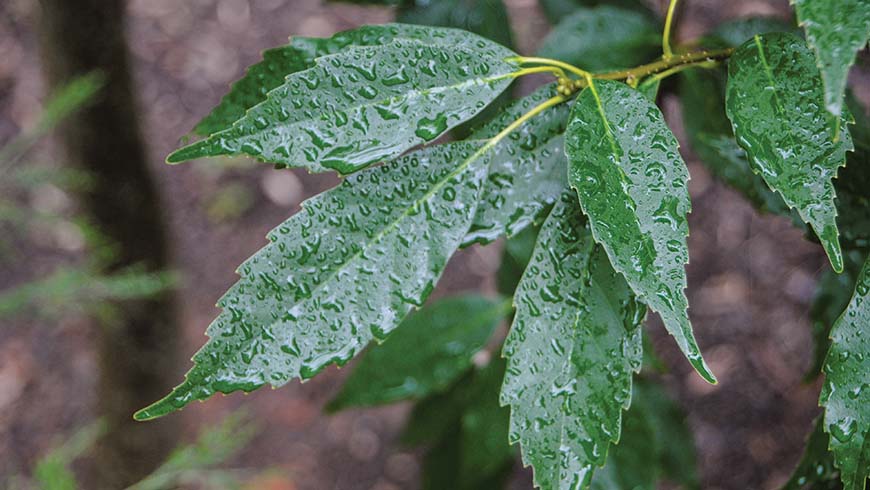
Of the 60 or so evergreen to mostly evergreen species the JCRA is currently or has recently grown, about 22 species have been in the ground for at least three to four years and most for over five years, offering the opportunity to observe them under a variety of conditions. Included in these evaluations are representatives from both subgenera and three of the four sections—Cerris, Lobatae, and Quercus. Several of the Asian species in the Cyclobalanopsis subgenus have proven to be good performers in the southeastern landscape and are grown with some limited regularity. Among the hardiest of these are Q. acuta, Q. glauca, and Q. myrsinifolia. Western Boulevard just to the south of the JCRA has rows of Q. myrsinifolia planted along it which have thrived over the decade plus they have been there. Several other Asian species show some promise for the Southeast, including Q. longinux (above) and Q. salicina (header).
For those interested in more information about the JCRA's evergreen oaks, with more in-depth information about the collections, I'll be happy to share the completed paper later in the fall—footnotes and all.
| Section | Evergreen/Deciduous | Identification Characteristics | Nativity |
|---|---|---|---|
| Cerris | Evergreen or deciduous | Leaf margins entire, revolute, or spiny; gray or yellow fascicled hairs on abaxial leaf surface | Asia, Europe, North Africa |
| Lobatae (red oaks) | Evergreen or deciduous | Leaf margins entire, serrate, or lobed; bristles on leaf tips; seed matures in two seasons (typically) | North America |
| Protobalanus | Evergreen | Leaf margins entire, dentate, or serrate; glaucous or waxy on abaxial leaf surface | North America |
| Quercus (white oaks) | Evergreen or deciduous | Leaf margins entire, serrate, or lobed; bristles absent; seed matures in one season (typically) | North America |
Table 1 Subgenus Quercus sections from Grimshaw
Arboretum Updates

Members Making News
By Mark Weathington, Director
We are very excited to announce that long-time JCRA partner and supporter Tony Avent (above), owner of the world-famous Plant Delights Nursery, has been named the 2018 Distinguished Alumnus for NC State University's College of Agriculture and Life Sciences. This high honor is given to two CALS alumni each year to recognize their outstanding career achievements and for their commitment to the land-grant principle of service to community, state, and nation. Recent recipients include former CALS dean, Johnny Wynne, and NC Secretary of Agriculture, Steve Troxler.
Tony's service to the JCRA has certainly been steady through the years from stints as the volunteer curator of the Lath House and tour guide to auctioneer at various events. His regular talks at the Arboretum are always among the best attended, and the Arboretum grounds are filled with plants shared from his nursery and the world-class Juniper Level Botanic Garden where his nursery resides.
Another member and former JC Raulston Arboretum director, Bob Lyons, Ph.D., is in the headlines as the Hamilton Award recipient from Rutgers University. The award recognizes "an unsung hero, a quiet leader, or patient mentor in the field of horticulture." Bob was a professor of mine at VA Tech a couple of decades ago before coming to NC State and the JCRA where he took J. C.'s legacy and ensured a long-term foundation. While he is a patient mentor and certainly a leader, I'm not sure I've ever heard him described as "quiet." At any rate, this award is very well deserved for his work at VA Tech, NC State, and the University of Delaware.
Bob's most enduring legacies at the JCRA are most obvious in the Ruby C. McSwain Education Center and the Bobby G. Wilder Visitor Center, both funded and built under his leadership. As a former student of his, I can attest to his passion for teaching and his support of students. In 2005, after his six-year tenure, the Dr. Robert E. Lyons JCRA Internship Endowment was created to support the hands-on experiential learning so critical for horticulture students.
If you would like to make a donation to this internship fund in Bob's honor, simply go online to http://go.ncsu.edu/lyons, call us, or send a check with the name of the internship in the memo line. We'll be sure to let him know of your generous contributions.
J. C. Raulston Distinguished Professor, Thomas Ranney, Ph.D., one of the premiere woody plant breeders in the world, is not only beautifying the planet with his new plants but is also making a difference beyond the landscape. One of Tom's most popular plant selections was the breakthrough pink mop-head form of our native smooth hydrangea. Sold in the trade as Invincibelle Spirit, the hydrangea (Hydrangea arborescens 'NCHA1') was the first of its kind.
In association with Proven Winners, $1.00 from each plant sold was donated to the Breast Cancer Research Foundation. After nearly 10 years of outstanding sales, the total donation has topped the goal of $1 million for breast cancer research.
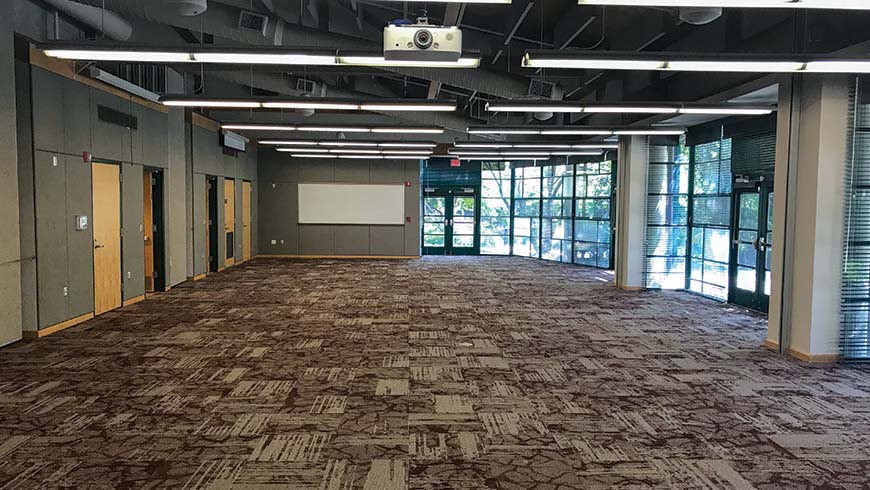
York Auditorium—Looking Great and Ready to Rent
By Arlene Calhoun, Assistant Director
Can you believe it's been nearly sixteen years since the Ruby C. McSwain Education Center was dedicated? September 21, 2002, was the date. I can't imagine the Arboretum without it. It is essential for our daily operations, and renting the York Auditorium is crucial to our daily revenue stream. We are very grateful to those who donated to our Raise the Roof campaign and made the dream of an education center come true.
The York Auditorium is used daily for a variety of gatherings. I'd love to know how many people have walked through its door—so many things learned, so many wonderful memories shared, so many friendships made. Try and imagine how many times the folding walls have been opened and closed, or how many times the tables and chairs have been moved to accommodate the endless number of room configurations. The auditorium is a popular place to meet, and we've been noticing for awhile that it looked used, well-loved, but very used. Marks on the walls, movable walls that no longer worked as they should, and stains on the carpet that were beyond the fix of the best carpet cleaners—not pretty.
I'm happy to let you know the tired, well-loved look is no more—the auditorium looks fantastic once again. Last year, we received the funding to update the space and we're excited to share it with you and those you know. A North Carolina Science Museums Grant allowed for the movable partitions to be replaced, and Richard and Amelia Lane funded our 2017 wish for new carpeting. Collective donations to our general fund paid for fresh wall coverings, and the university put a fresh coat of paint on the walls. We're thrilled, and we can't wait for you to see it.
Interior designers at NC State University helped create a calming and botanically inspired palette. One that should hold up to the test of time that is sure to include many more wonderful memories with a few coffee and red wine spills added. Stop in and take a look. Notice the subtle reed pattern on the new wall coverings and dappled shade effect on the new carpet tiles. We think it looks fresh and fabulous and blends perfectly with the notable architectural features of the Ruby C. McSwain Education Center.
For those who don't know and a reminder for those that do, the York Auditorium is available to rent. You can easily check availability, rental rates, room capacities, and rental policies on our Web site at https://jcra.ncsu.edu/rentals/. Chris Ferguson, our facility and rental coordinator, is happy to help with your next meeting, party, or gathering. He can be reached at chris_ferguson@ncsu.edu or (919) 513-7457.
We are grateful for the generosity of those that continue to support our mission and recognize the value of our operational necessities. We haven't finalized our 2018 wish list, but don't be surprised if you see chairs high on the list. Both our indoor and outdoor chairs have sat many a derrière, and they are starting to show it.
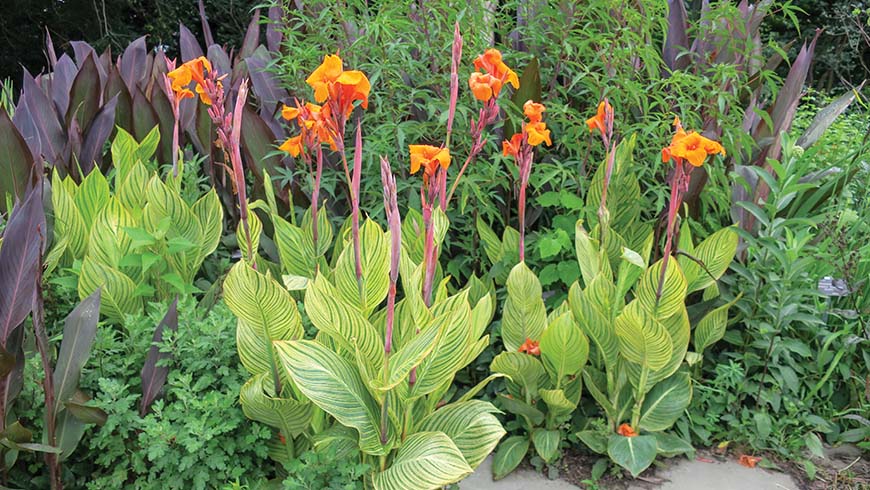
Gardening in the South Series—Welcoming New Gardeners to the Triangle Area
By Arlene Calhoun, Assistant Director
Our community is growing, and you don't have to look far to see it. Surveys across the nation regularly put the Triangle area in the top five places to live in the country—no secret there. Those of us already here know how wonderful it is, and we also know not to close our eyes for too long or we may not recognize where we are when we reopen them.
With so many newcomers moving into the area, you have to think there are a significant number of gardeners among them. And because we know a thing or two about transplants and are an extra friendly bunch, we put our heads together, threw out the welcome mat, and designed a program to quickly acclimate these newcomers to gardening in the South. Let's face it, meeting people with like interests and getting your hands in the dirt are important steps in making any new place feel more like home.
Our objective clear—meaningfully introduce the Arboretum to as many newcomers as possible. The criteria set—anyone who is new to the area or new to gardening in the area. This includes those who find themselves with newly acquired time to get their hands in the dirt. Our mission—to introduce them to the Arboretum and its mission along with a few Arboretum friends and to help them feel at home with trusted gardening resources in the horticulturally rich community they now call home.
The new Gardening in the South series was launched in late July with the Summer Gardening Symposium. It exceeded our expectations with over 145 gardeners registered, 20 immediately joining our membership family, and all excited about gardening in the South. The collective gardening knowledge ranged from beginner to full-fledged with most owning their own schedule, allowing them to play in the dirt anytime—sounds like a perfect match.
The program was free, but our Southern hospitality didn't end there. Our friends at Neomonde provided a bountiful complimentary breakfast, and our gardening experts, Bryce Lane, Anne Spafford, and Mark Weathington delighted the crowd with talk of basic gardening practices, design principles, and insider information any newcomer would need to know to successfully garden in the South.
The pilot program was so successful that the Raleigh area tree experts at Leaf & Limb have committed to sponsoring more of these half-day programs over the next year. Sponsorships like this are important to increasing the Arboretum's community outreach, keeping the Arboretum visible to the community, ultimately providing a pipeline to the funding needed to keeping our programs going and our gates open every day of the year.
We can't do it alone and we thank every one of you who continue to support our mission and introduce people you know to the Arboretum. And for those of you who feel you missed out on a wonderful program, Chris Glenn recorded them for you to view as you please. They can be found on the Arboretum's YouTube Channel at https://www.youtube.com/user/jcraulstonarb.
Volunteering
Volunteer Spotlight: Colin Daniels
By Kathryn Wall, Membership and Volunteer Coordinator
It's always bittersweet when one of our volunteers moves away, and we recently bid farewell to one of our longest serving volunteers, Colin Daniels (above, right). She has been a weekly fixture in the office helping with membership and volunteer tasks for almost 19 years! Though we hated to lose her, Colin and her husband, Charles, and much loved labradoodle Maggie, decided to downsize and move to the North Carolina coast.
During Colin's 19 years at the JCRA, she worked with four directors, two interim directors, and five volunteer coordinators! She jokingly said the only staff member she hadn't outlasted was Chris Glenn, JCRA's programs and education coordinator, who has been at JCRA since November 1999.
Colin came to the JCRA through her love for plants. She moved to Cary in 1999, and wanted to improve the backyard on her newly constructed house. "I didn't know a hellebore from a zinnia," said Colin. She contacted a local design firm and ended up working with Harriet Bellerjeau, a former JCRA volunteer coordinator and master plan committee volunteer. One day, Harriet told Colin "If you really love plants, you should volunteer at the Arboretum." Colin had recently retired after 20 years and was available to help.
She started volunteering in November 1999. Her first assignment was to staff the little red brick building. It was a quasi visitor center, but she didn't see too many visitors in 1999. In fact, she said it was a little too isolated for her to really enjoy it. She was given a stack of volunteer sign in sheets that dated back six months to enter in the computer. She finished that task about the same time as she was asked to work in the Kilgore Hall office and handle Arboretum memberships and renewals each week. Since Colin enjoyed working independently, she said this was a good fit for her and she just kept coming back.
Colin said she enjoyed working with different staff members and other volunteers, who each brought something different to the JCRA. Over her nearly 19 years as a volunteer, she saw tremendous growth in membership and an influx of new volunteers. Until just recently, when you opened your new membership materials, they were folded carefully by Colin. (She is the fastest, most efficient letter folder I've ever seen!) If you volunteered and scrawled your name and time on the volunteer log, Colin deciphered your handwriting and put that data into our system.
Colin is hoping to join a local garden club and volunteer at a public garden in her new home. We wish her the best and hope that whomever she decides to volunteer with appreciates and loves her like we do.
Before she left, Colin helped train her worthy replacement, Gale Koonce (above, left), who has taken on the weekly job with a smile. Gale has a background in accounting and offered to step into this regular role. Gale's spouse, Faye, was a longtime staff member at JCRA and is a frequent front desk volunteer.

